Related Research Articles

Sir Joseph William Bazalgette CB was a British civil engineer. As Chief Engineer of London's Metropolitan Board of Works, his major achievement was the creation of a sewerage system for central London which was instrumental in relieving the city of cholera epidemics, while beginning to clean the River Thames. He later designed Hammersmith Bridge.

The London sewer system is part of the water infrastructure serving London, England. The modern system was developed during the late 19th century, and as London has grown the system has been expanded. It is currently owned and operated by Thames Water and serves almost all of Greater London.
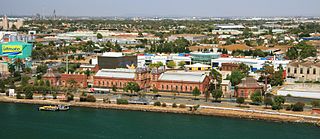
Spotswood is an inner-city suburb in Melbourne, Victoria, Australia, 7 km (4.3 mi) south-west of Melbourne's Central Business District, located within the City of Hobsons Bay local government area. Spotswood recorded a population of 2,820 at the 2021 census.
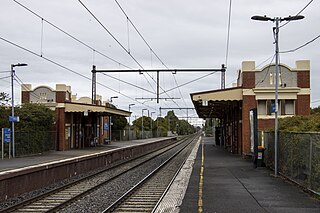
Spotswood railway station is located on the Werribee and Williamstown lines in Victoria, Australia. It serves the western Melbourne suburb of Spotswood, and opened on 1 December 1878 as Edom. It was renamed Bayswater on 1 September 1881, renamed Spottiswoode on 1 October of that year, and renamed Spotswood on 1 August 1905.
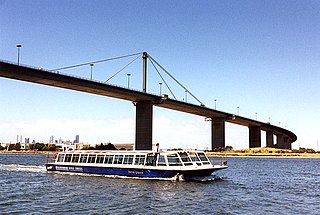
The West Gate Bridge is a steel, box girder, cable-stayed bridge in Melbourne, Victoria, Australia, spanning the Yarra River just north of its mouth into Port Phillip. It carries the West Gate Freeway and is a vital link between the Melbourne central business district (CBD) and western suburbs, with the industrial suburbs in the west, and with the city of Geelong 80 kilometres (50 mi) to the south-west. It is part of one of the busiest road corridors in Australia. The high span bridge was built to allow large cargo ships to access the docks in the Yarra River.

Abbey Mills Pumping Station is a sewage pumping station in Mill Meads, East London, operated by Thames Water. The pumping station lifts sewage from the London sewerage system into the Northern Outfall Sewer and the Lee Tunnel, which both run to Beckton Sewage Treatment Works.

The Great Stink was an event in Central London during July and August 1858 in which the hot weather exacerbated the smell of untreated human waste and industrial effluent that was present on the banks of the River Thames. The problem had been mounting for some years, with an ageing and inadequate sewer system that emptied directly into the Thames. The miasma from the effluent was thought to transmit contagious diseases, and three outbreaks of cholera before the Great Stink were blamed on the ongoing problems with the river.
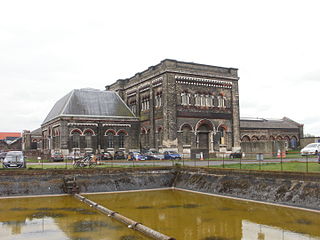
The Crossness Pumping Station is a former sewage pumping station designed by the Metropolitan Board of Works's chief engineer Sir Joseph Bazalgette and architect Charles Henry Driver. It is located at Crossness Sewage Treatment Works, at the eastern end of the Southern Outfall Sewer and the Ridgeway path in the London Borough of Bexley. Constructed between 1859 and 1865 by William Webster, as part of Bazalgette's redevelopment of the London sewerage system, it features spectacular ornamental cast ironwork, that Nikolaus Pevsner described as "a masterpiece of engineering – a Victorian cathedral of ironwork".
The Melbourne and Metropolitan Board of Works (MMBW) was a public utility board in Melbourne, Australia, set up in 1891 to provide water supply, sewerage and sewage treatment functions for the city. In 1992, the MMBW was merged with a number of smaller urban water authorities to form Melbourne Water. MMBW was abolished in 1992.

The Federation Trail is a 23-kilometre-long (14 mi) shared use path for cyclists and pedestrians, which mainly follows the heritage-listed Main Outfall Sewer through the western suburbs of Melbourne, Victoria, Australia. There are three bridges spanning across major arterial roads, as well as button-activated traffic light crossings at most other major road-trail intersections.

The Western Treatment Plant is a 110 km2 (42 sq mi) sewage treatment plant in Cocoroc, Victoria, Australia, 30 km (19 mi) west of Melbourne's central business district, on the coast of Port Phillip Bay. It was completed in 1897 by the Melbourne and Metropolitan Board of Works (MMBW), and is currently operated by Melbourne Water. The plant's land is bordered by the Werribee River to the east, the Princes Freeway to the north, and Avalon Airport to the west. It forms part of the Port Phillip Bay and Bellarine Peninsula Ramsar Site as a wetland of international importance. The Western Treatment Plant treats around fifty percent of Melbourne's sewage — about 485 megalitres or 393 acre-feet per day — and generates almost 40,000 megalitres or 32,000 acre-feet of recycled water a year.

William Thwaites (1853–1907) was a civil engineer working in Melbourne, Australia in the late nineteenth and early twentieth centuries. He was responsible for the design and supervision of construction of Melbourne's sewerage system.

The Barwon Sewer Aqueduct is a heritage-listed aqueduct across the Barwon River at Goat Island, Breakwater, Victoria, Australia. It was designed by engineer E. G. Stone and was erected between 1913-1915. It would appear to be the only one of its kind in Australia in terms of its length and the use of Considère's construction technique. The aqueduct appears to be the last example in Australia of Armand Considère's system of reinforcing for concrete structures. It was added to the Victorian Heritage Register on 23 October 1991.
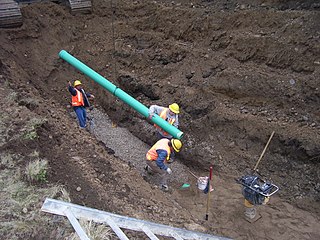
A gravity sewer is a conduit utilizing the energy resulting from a difference in elevation to remove unwanted water. The term sewer implies removal of sewage or surface runoff rather than water intended for use; and the term gravity excludes water movement induced through force mains or vacuum sewers. Most sewers are gravity sewers because gravity offers reliable water movement with no energy costs wherever grades are favorable. Gravity sewers may drain to sumps where pumping is required to either force sewage to a distant location or lift sewage to a higher elevation for entry into another gravity sewer, and lift stations are often required to lift sewage into sewage treatment plants. Gravity sewers can be either sanitary sewers, combined sewers, storm sewers or effluent sewers.
The Bondi Ocean Outfall Sewer is a heritage-listed sewerage infrastructure at Blair Street, North Bondi, Sydney, Australia. The sewer line commences at the intersection of Oxford Street and College Street in Darlinghurst and then travels in a more-or-less easterly direction for 6.1 kilometres (3.8 mi) passing through a number of suburbs until it reaches Blair Street in North Bondi. It was designed and built by the Public Works Department between 1880 and 1889. It is also known as BOOS (Bondi Ocean Outfall Sewer) and Main Northern Ocean Outfall Sewer. The property is owned by Sydney Water.

The Cooks River Sewage Aqueduct is a heritage-listed sewage aqueduct located at Pine Street, Earlwood, New South Wales, Australia. It crosses the Cooks River to Thornley Street, Marrickville. It was designed by Sewerage Construction Branch and NSW Department of Public Works and built during 1895 by J. F. Carson, contractor. The property is owned by Sydney Water, an agency of the Government of New South Wales. It was added to the New South Wales State Heritage Register on 18 November 1999.

The Wolli Creek Aqueduct is a heritage-listed sewage aqueduct located at Unwin Street, Earlwood, City of Canterbury-Bankstown, New South Wales, Australia.

The Double Bay Compressed Air Ejector Station is a heritage-listed former sewage pumping station (SPS87) and now decommissioned sewerage infrastructure in Jamberoo Lane, Double Bay, adjacent to the rear boundary of 63 William Street, in the Municipality of Woollahra local government area of New South Wales, Australia. The site of the pumping station and the State Heritage Register curtilage is shown on SHR:01324–Plan 2019, reproduced on the internet page referenced here.

The Ultimo Sewage Pumping Station is a heritage-listed sewerage pumping station located at William Henry Street in the inner city Sydney suburb of Ultimo in the City of Sydney local government area of New South Wales, Australia. As a result of the construction of an elevated roadway along William Henry Street, the pumping station now fronts Pyrmont Street, with vehicles being required to enter via Quarry Street, then turning right into Pyrmont Street.
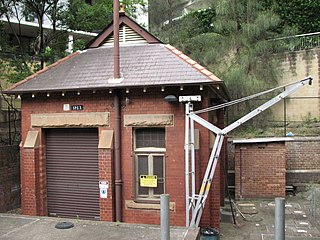
Sewage Pumping Station 3 is a heritage-listed sewerage pumping station located near 1 Booth Street, Annandale, City of Sydney, New South Wales, Australia. The building is located adjacent to Johnstons Creek. It was built from 1902 to 1904 by the New South Wales Public Works Department. It is also known as SPS 3, SP0003, Booth Street Sewage Pumping Station and Annandale Sewage Pumping Station. The property is owned by Sydney Water. It was added to the New South Wales State Heritage Register on 18 November 1999.
References
- 1 2 Werribee Sewage Farm Victorian Heritage Database, Heritage Victoria
- ↑ 'Tunnelling Triumph' Spotswood Pumping Station, Museum Victoria
- ↑ "Spotswood Sewer Disaster". www.westgatebridge.org. West Gate Bridge Memorial Committee [sic]. Archived from the original on 19 August 2006. Retrieved 9 August 2015.
- ↑ "The Sewer Accident" (scan). The Argus . No. 15, 232. Melbourne, Australia. 25 April 1895. p. 6. Retrieved 8 June 2022– via Trove.